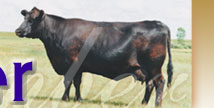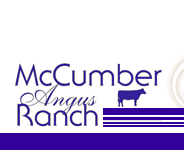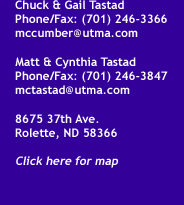 |
 |
|
Two of the females that have these desirable traits are Miss Wix 365 of McCumber and Miss Wix 235 of McCumber. It is in these females that we are concentrating the genetics of our herd through the use of their sons and grandsons. It is proven females such as these that allow us to breed McCumber 054 Rito 5009 to daughters of McCumber 124 Traveler 212; both bulls are sons of Miss Wix 365 of McCumber. The son of Miss Wix 235 of McCumber, McCumber Foundation 701, can then in turn be mated to many of the granddaughters of Miss Wix 365 of McCumber to stack these great females into the pedigree. The resulting progeny are among the most promising and most consistent for type and performance of all that we have produced. The cows and heifer calves at McCumber are maintained on a high roughage ration through the winter months that consists of corn silage, alfalfa hay and straw which is ground, mixed together and fed in a fence-line bunk. Feed samples are taken in the fall and the resulting analyses are used to balance a ration that will maintain the older females and allow the heifer calves to develop without getting fat. The bull calves are also fed at the ranch on a high roughage ration that consists of corn/oats mix, corn silage and alfalfa hay. This ration is balanced, mixed together and fed in a fence-line bunk to allow the bull calves to grow and develop at the rate of 3 lbs./day. The grain in the ration is held to around 1% of the bullÕs body weight, never to exceed 12 lbs. of grain in the ration. These bulls can then go out and breed cows for our customers while maintaining their health and soundness. The pastures at McCumber are mainly native pastures with some introduced cool season grasses and also with some warm season grasses that allow us to rotate the cattle between pastures during the different seasons. We normally do not go to pasture with the cows and calves until the last week in May which allows us to finish our artificial insemination (AI) program while the cattle are still at home. There could be some early grazing by the middle of May, but holding the cows off the pastures until the grasses have a good start ensures us of better grazing throughout the summer. Haying starts in the northern part of North Dakota around the middle of June for the first cutting of alfalfa. This is followed by the haying of our meadows. The second cutting of alfalfa is taken in late July to early August, which allows the plants to recover well ahead of the first killing frost. The average killing frost date is around September 10 for this part of North Dakota. Corn silage is chopped sometime in September, usually after a frost; if it is mature, we will start before a frost. We pull a dump wagon behind the chopper that can dump the silage into a truck to be hauled to the ranch. It is then piled and packed into a bunker silo on top of the ground. Calving starts the very last days of January for the two-year-old heifers and around the tenth of February for the rest of the cow herd. It can be very cold at that time of year so many of the cows are brought into our calving barn to calve or are brought in shortly after the calf is born. This is a barn that consists of 12 pens. The cow and her newborn calf are in the barn just long enough for the calf to be dried off and start nursing. The calves are weighed and tagged. The pair are then moved to a corral that has protection from the wind and the calves can go into a bedded barn. This is a busy, but exciting time of the year.
We hold our annual bull sale at the ranch near the end of March. All bull calves that have acceptable performance and have passed their fertility tests are sold. The bull calves that are not good enough in the fall to be kept as a potential bull are castrated and often sent to a feedlot to be finished. We collect carcass data on all our calves that go on to the feedlot. We have many visitors throughout the year (mostly in the summer). We would be happy to have you visit and view the ranch and cattle. |




